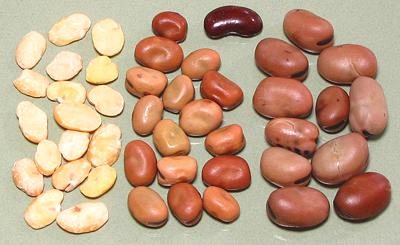 [Ful Hamam, Fool (Egypt); Vicia faba alt Faba sativa]
[Ful Hamam, Fool (Egypt); Vicia faba alt Faba sativa]
These are actually a variety of Fava Bean that is small and round. We break them out separately due to their importance for a single dish, Ful Medamis, practically the "national dish" of Egypt, and popular in surrounding countries as well. These beans are available dried and canned. The photo shows soaked beans to the right, dry beans in the center and peeled beans to the left. I'm not sure what the peeled ones are used for, but they aren't the right thing for Ful Medamis. The dried beans are up to 0.50 inches long.
More on Beans, Peas & Lentils
For the larger, flat fava beans - Egyptian Ful Roomy (Greek Beans) see our Fava Beans page.
These beans are available canned, usually labeled "Ful Medamis", but preparing them yourself from dried beans is greatly superior. The procedure is as follows:
As you can see, it takes a long time, but very little work or attention.
This is repeated from our Fava Beans page. Fava beans are known to be deadly to people with a genetic deficiency of the enzyme glucose-6-phosphate dehydrogenaise (G6PD), children being particularly vulnerable. While rare, this deficiency is found in some ethnic groups, Africans and people of Mediterranean descent - ironically the regions where fava beans are most consumed.
This enzyme deficiency is thought to provide some protection against malaria, but without the enzyme to detoxify fava beans, fever, heavy loss of red blood cells and a yellow complexion result. Survivors recover completely but blood transfusion may be needed in severe cases. Favas should also be avoided by people taking MAOI antidepressants.
On the plus side, Favas are high in L-dopa which is used to treat Parkinson's disease and may be helpful in reducing high blood pressure. It is also reputed to increase human libido and help with erectile disfunction.
bp_fulz 070325 - www.clovegarden.com